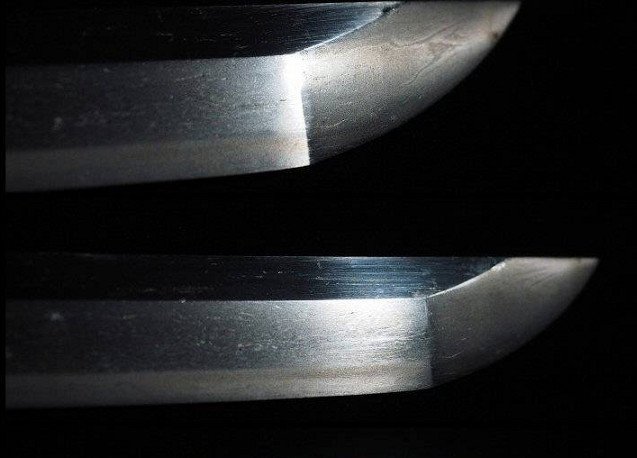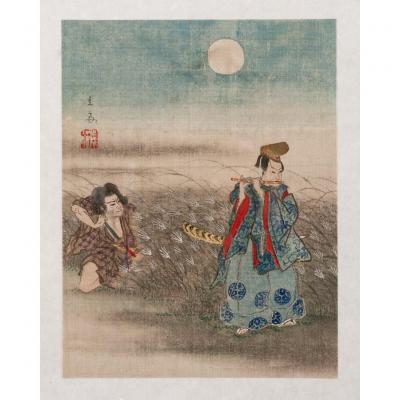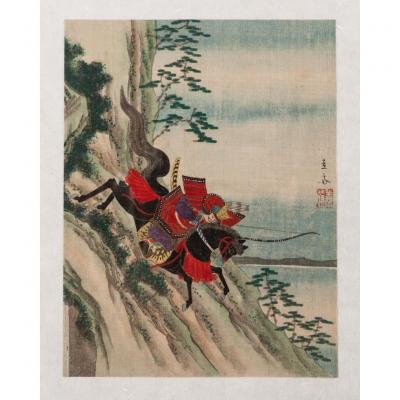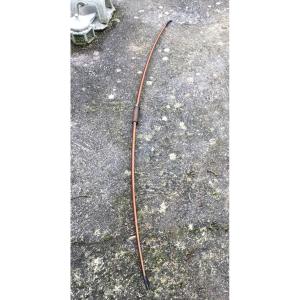The swords are described according to current knowledge of the object and can be modified at any time, depending on how this knowledge evolves. The descriptions are not Expertise, but reflect the knowledge acquired on the subject. All information contained in this document (which may be modified at any time) is provided for information purposes only and cannot be considered contractual and does not in any way bind the people who wrote it. They are carried out in complete transparency and made in good faith, without falsification of any kind.
DESCRIPTION : This very old sword, over 800 years old (late Heian, early Kamakura), is an extremely rare piece, both in terms of its history and its state of conservation, with its Nakago and Nagasa “Ubu”, i.e. no shortcuts, but also a very important characteristic about the value of this sword, because the swords of this very famous blacksmith, (part of the Goban Kaji, 50 privileged blacksmiths of Emperor Gotoba, manufacturer in Spring), is one of the characteristics of the 2 Bungo Yukihira swords held by the Imperial Palace called O-mono, are both used during very important imperial enthronement ceremonies, etc., moreover they are also "Ubu", just like the National Treasure Bungo Yukihira, and the 2 other Bunkazai from the same craftsman, as well as by its provenance confirmed by its Torokusho which make it a Daimyo Toroku, from its place of origin (Oita Prefecture). He also bears a signature on his Nakago and a Shirasaya-gaki, which with his N.T.H.K certificate, confirms his identity and authenticity.
Blade of very good quality and in excellent state of conservation given its very old age. Certificates and Document: Certificate of authenticity from N.T.H.K Tokyo, Hoju and Sayagaki from an expert designating this blade as "Kishin Daiyu Yukihira" and thereby mentioning a Zaimei, with his Torokusho (Daimyo Toroku) No. 3953, dated from Showa 12/28/16 (December 16, 1953).
• Signature: Zaimei (signed) in Tachi Omote Mei (Very rare). Due to the extreme age of this blade, the signature on Nakago has partly disappeared, but remains partially visible, which allows us to determine the following signature: “豊後国行平作”, or “Bungo no Kuni Yukihira”. In addition, a secret symbol, the meaning of which we do not know, has been integrated into this signature. According to recent readings, Bungo Yukihira also marked his swords with a symbol: 品ou區lu “Shina or Hin”. It is very possible that this is the symbol found on the silk of this Tachi.
• “Bungo no Kuni Yukihira” is one of the signatures of “Kishin Daiyu Yukihira”, moreover, only the blades of Yukihira, Kishin-Daiyu have a signature “Tachi Omote Mei”, all the other blades of the other Yukihira have a signature in “Tachi Ura Mei.” Another essential information, the name Kishin-Daiyu relates to a particular period, the very beginning of the Kamakura Period, Genkyu era which goes from 1204 to 1206. This same name appears in the Sayagaki calligraphed in full.
• Sayagaki (Inscriptions on the Saya most likely made by “Dr. Honma Junji” also known as Kunzan). Dr. Honma was the great specialist in Koto blades, author of numerous works, while his younger sidekick Kanzan Sato was the specialist in Shinto blades. Dr Honma was also the 1st CEO of the N.B.T.H.K, at the time of its creation, in order to promote Japanese swords as works of art in their own right. He also created his own Japanese Sword Museum, and held numerous official positions.
• Blacksmith's name: Hoju/Yukihira (在銘) (紀新太夫行平と鞘書き有り).
• Period: Late Heian, very early Kamakura period (1184-1336) 紀新太夫行平/ Genkyu era which goes from 1204 to 1206.
• Blacksmithing school: Mokusa Hoju Ha/Yukihira. • Location: Mutsu Province "陸奥" Tohoku/Bungo Kyushu, this blacksmith has traveled extensively, and also exiled on at least two occasions, he also happens to be at the origin of Yamato-Den. CHARACTERISTICS: The characteristics of this blade correspond to those commonly made by “Kishin Daiyu Yukihira”.
• Total blade length: 94.7cm
• Nagasa: 68cm刃長 (Nagasa) 二尺二寸三分九厘強 (2Shaku,2Sun,3Bu,9Ri (almost 4Bu) 67.86 cm • Weight: 525 grams
• Sori: Height: 2.4 cm 反り(Sori) 七分九倫 (7Bu 9 Rin) - Type: Koshi-zori
• Mekugi-ana: Number: 1
• Nakago type: Furisode-gata (consistent with what was done during the Kamakura period) – Nakago-jiri (End) type: Ha-hagari-kurijiri - Ubu, (Original and uncut) very old type . An Ubu Katana blade from this era is Extremely Rare.
• Mune type: Iori Mune • Nagashi: Polisher's marks on the Mune at Kissaki and at Moto-kasane. Uncommon.
• Sugata type: Shinogi-zukuri – Dimensions: Moto-haba: 2.74cm/Moto-kasane: 6.3mm, Saki-haba: 2.07cm/Saki-kasane: 4.5mm
• Grooves: No-hi (without)
• Jihada type: O-itame-Hada mixed with Hayasugi-hada, in Jinie
• Hamon type: Chu-Suguha
• Kissaki type: Chu-Kissaki • Boshi type: Hakikake (consistent with what we find on blades signed “Bungo-no-Kuni Yukihira Saku”)
• Defects: Presence of Tateware, completely normal defects on a blade over 800 years old.
SHIRASAYA:
• This Tachi is in Shirasaya and without Koshirae. The Shirasaya includes a Sayagaki (Calligraphic inscription on the Saya). Translation: (在銘) (紀新太夫行平と鞘書き有り). The Sayagaki calligraphed by Dr Honma Junji known as Kunzan, are sober, with essential information only.
• Habaki type: Yujyo, in one part. Materials: brass covered with silver leaf.
PRICE :
• Final sale price with shipping costs. Blade: €120,000 (Without Koshirae) Delivery included. The addition of a high quality Koshirae is being considered for this exceptional piece (at an additional cost).
• A study carried out by a family of great American collectors on Kishin Daiyu Yukihira demonstrated that if they asked to have a sword made with the same quality, the same technical characteristics by a living National Treasure (Ningen Kokuho), this would amount to a minimum from 60 to 80 KS. If we add the 820 years of conservation, patina and notoriety, we easily arrive at a Juyo Token, or even Bunkazai or Kokuho, which are traded at several hundred million Yen, but as it does not none exist on the market...The most expensive saber in the world came from the Compton Collection, sold for US$460,000.
APPENDICES
This blade was forged following the “Yamashiro-den” tradition of the “Mokusa Hoju” School which began in the middle of the Heian period and continued during the Kamakura and Muromachi periods. It is said that this School is at the origin of the development of the Yamashiro-Den Tradition, after returning from the Northern Provinces: Dewa, Mutsu, before returning to their initial Province of Bungo in Kyushu (Southern Japan). It is also the starting point of the Japanese sword that we know today. Hoju swords were given special attention as good luck charms, and were often placed alongside aristocratic women ready to give birth. Moreover, the great Shogun Toyotomi Hideyoshi greatly appreciated these swords (page 155 of Connoisseur’s Book of Japanese swords).
• The Boshi of Yamashiro-den blades generally became Hakikake (as on our blade), Kaen or Yakitsume with a very short Kaeri. The Hakikake Boshi is a Boshi that splits into several Sunagashi (parallel lines) which are reminiscent of the traces left by a broom. • The Hamon of Yamashiro-den blades were generally in Suguha in Nie-deki with Ji-nie and Chikei (as on this blade).
• The Hada of Yamashiro-den blades were generally in Masame-hada or O-Itame Hada and O-Mokume Hada with Jinie Utsuri. (As on the blade which is made of O-itame Hada mixed with Hayasugi Hada). The Hayasugi Hada: appears in the form of large regular waves.
• The Nakago of Yamashiro-den blades were generally long, thin and curved (as on this blade).
• The Sugata (form) of the Yamashiro-den blades were generally narrow, especially near the line of the Yokote. The bottom of the blade had a Fundari, the Kasane only became thicker from the middle of the Kamakura period. The blades had a small Kissaki with a Fukura and the Shinogi was thick with a Gyo-no-mune or Shin-no-mune.
N.T.H.K CERTIFICATE:
Translation of the certificate:
• N.T.H.K expertise, dated Nov. 14, 2021
• Hoju declared Kamakura period.
• Mutsu no Kuni
• 7 Jurors approved the decision.
• 太刀 無銘 寶壽
• 古刀 鎌倉時代後期(正中頃/1324~)陸奥
• 刃長82.5cm 反り3.4cm 元幅32.3mm 元厚6.9mm 先幅16.6mm.
Translation of Sayagaki:
• Calligraphy on the Saya (在銘) (紀新太夫行平と鞘書き有り). The Sayagaki calligraphed by Kunzan are easy to recognize, because he generally did not make comments and simply indicated the words: “Kantei/Hacho (Nagasa)/Mei - name: Honma Junji”, except for his personal collection.
Essay on the Tachi sword, Kishin Daiyu Yukihira and its main characteristics:
This sword is of particular interest because it is firstly a historical piece, which dates from around 819 years ago (late Heian period-early Kamakura period), it is then accompanied by an official Torokusho (weapons registration document) , which by its date of registration notifies a Daimyo Toroku, i.e. the former membership of a very old aristocratic (Kuge), or military (Bushi) family. Aside from this historical information, this sword is in its original integrity, and therefore has not been shortened in one way or another, often at the tang, which is for a Tachi of this period, extremely Rare! They say he is Ubu. While observing it from the outside, it is protected by a wooden sheath, called a saya, which protects it as best as possible from the external environment, and in this case from humidity.
In addition, this scabbard includes manual inscriptions calligraphed in black ink, indicating the name of the blacksmith who made it: 紀新太夫行平, then the inscription Zaimei chu, presence of the signature, and its dimensions, without signature from the author of the calligraphy, but presence of a label, very likely from Private Collection. This sword has another interesting characteristic to note, it has only one Mekugi-ana, or a single perforation in the tang, which for a sword of this period is also extremely rare, and which would confirm that it does not only belonged to one and the same Family (due to its importance) and thus to have been transmitted from generation to generation. Its general shape corresponds well to the general characteristics of this period, particularly the shape of the curvature, the shape of the tang and the Ko-kissaki, a small tip.
By observing the blade we see that along its length it has 3 zones of different colors, the darkest close to anthracite gray located near the outer edge worked in O-Itame-hada, then the second less wide worked in the same way but mixed with regular curved Ayasugi-hada in millefeuille giving the appearance of waves on sand, and the third, finer in metal gray color presenting the different working patterns of the blade as in the second part, based on Suguha in Nie-deki, Jinie and Chikei, with Sunanagashi, and Hotsure. Or a blade with exceptional forging work, like a seaside landscape. There are also characteristics that validate a blade from this artisan blacksmith, as we can see on blades recorded in Kokuho or Bunkazai, not to say Juyo-token, from this same craftsman. In comparison with Mokusa Hoju blades which do not have this gradient of colors in the steels of the blade, but which are much darker in appearance due to a different origin of the iron ore, and more contemporary, mid-late Kamakura period .
The conservation conditions of this Tachi are quite exceptional, and unique due to its rarity, evidenced by its original “Ubu” character, its Torokusho characterized by its date in Daimyo Torokusho of origin from the Province of birth of the blacksmith, his Sayagaki which announces the zaimei and which gives fairly precise information on the period when this sword was made, by its name: Kishin Daiyu Yukihira (紀新太夫行平) - Name of the craftsman which corresponds to the Genkyu era (1204-1206). The very likely author of the Sayagaki would be Dr Junji Honma, a personality and world reference in Koto swords, like this one.
This ancestral weapon has an appearance that is both slender, very finely worked, but also powerful and noble, like its Sori curvature, typical of this era, and an indisputable presence, are some of the characteristics that make this saber , a true museum piece that will be a worthy addition to your Collection.

















































 Le Magazine de PROANTIC
Le Magazine de PROANTIC TRÉSORS Magazine
TRÉSORS Magazine Rivista Artiquariato
Rivista Artiquariato